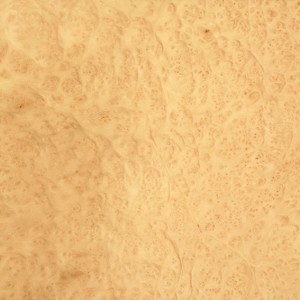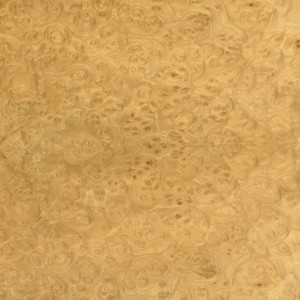When producing real wood veneers, four main sections of the tree are used: the stump, the trunk, the crotch and the burr.
The stump of the tree produces veneer pieces that are small in size and have swirly, twisted patterns. The trunk, which starts just above the stump and runs up to just below where the limbs branch off (the crotch), produces long veneer leaves using a range of veneer cutting techniques.
The crotch, being where the limbs of the tree branch off, naturally produces a swirly grain pattern that transforms into a full flame figure. The trunk of the tree will often grow deformed, wart-like protrusions or knots. These are called burrs or burls and when sliced into wood veneers they display stunning patterns that resemble eyes.

Whilst crotch and burr veneer can be a challenge to work with, the results of expert veneer matching and finishing are often nothing short of spectacular. Yes, a great deal of patience is called for when, as is in-depth knowledge of how to effectively and carefully press veneers taken from these parts of the tree. And yes, crotch and burr veneers are generally at the higher end of the price scale. However, the end product is so eye-catching, unique and elegant that it makes it all worthwhile.
At Read Veneers we work with crotch and burr veneers on a fairly regular basis, in particular for our bespoke furniture maker clients. These decorative wood veneers really do stand out when used as panelling in cabinets and as part of a bespoke kitchen or bedroom design. Here we have listed some of the most popular species we work with so that you can see the effects that can be achieved.
Maple Burr Veneers
There is a wide choice of maple veneers including maple burr and cluster, from which there is further choice of maple cluster, maple burr (full burr) and maple burr (open burr). Hard maple produces birds eye maple which features unusual round markings.
Myrtle Burr Veneers
Myrtle trees tend to grow numerous burrs up and down their trunks, producing beautiful patterns that resemble rippling water through glass. Myrtle cluster is another version of myrtle burr which has less frequent but deeper shaded markings.
American Walnut Burr Veneers
Deep and rich in colour and strikingly eye-catching courtesy of its swirling pattern punctuated by unique knots and eyes, American walnut burr is one of the most desirable veneers in the realm of bespoke, high specification cabinetry.
Magnolia Burr Veneers
Light in shade and featuring an intriguing bubbling effect, magnolia full burr works very well inset into wood veneer panels to create highly attractive doors and cabinet fronts. Magnolia open burr has an air of classic sophistication about it and would not look out of place in a period reproduction piece of furniture.
Like what you see and interested to view more? Follow this link to view our full range of veneers, including crotch and burr veneer varieties. Looking for advice on which veneer to choose for your project? We’re here to help so please get in touch.












